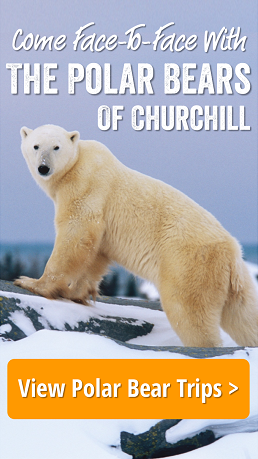by Steve Selden | Feb 3, 2011 | Tour News
As winter has settled in to an up and down cycle of cold and colder, everything around has frozen and most life aside from the human population has come to a standstill. Temperatures are just below freezing again- considered a thaw by most Churchillians- though expected to dip again by weeks end into the -25C to -35C range. Sunrise is at 8:22 and sunset at 4:39…so the days are expanding grudgingly like the crusted ice pans in the Hudson Bay.
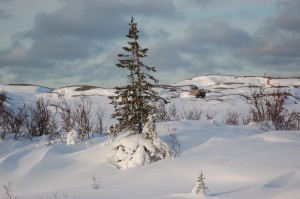
Photo: Steve Selden
While the omnipresent ravens appear all around Churchill, foxes-both red and arctic- also roam the tundra and town alleys searching for one more morsel of sustenance to get them through the chilled night. The braver, more adventurous of both species follow the polar bears out onto the Hudson Bay where food becomes available in the scraps of seal-kills by the massive bruins. These provide larger amounts of food at one time with much more exposure and risk coming along with the bounty. Weather is unforgiving out on the ice with little shelter other than the elevated pressure ridges formed from colliding ice floes. And then there’s the risk of getting too close to a bear and becoming an arctic home -run of sorts. Winter ball at its’ best.
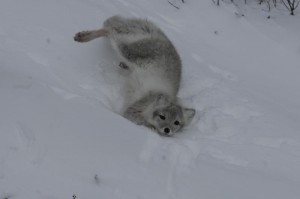
Photo: Paul Brown
So..that is why many of these beautiful critters opt to stay at home around Churchill , their home range, where food supply..living and non-living can be scavenged and shelter comes in a variety of forms.
Although the arctic North has traditionally been territory of the arctic fox, the red fox is winning the “evolutionary” tundra war so to speak. Arctic foxes are physically more prepared for the frigid elements in the North with a smaller body mass, fur lined soles of their feet, and apt white furry camouflage. They are the perfect species “team” on paper…the club that will endure forever and win the championship without playing the games. However, mother nature doesn’t work that way….and there is a scrappy contender in the picture now….the red fox.
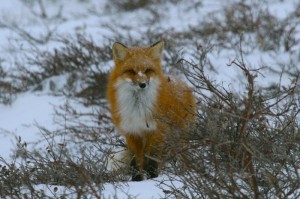
Photo: Paul Brown
The red fox has persevered without the tools of the arctic fox. Both have extensive similarities such as average lifespan of three to four years, gestation period of about 52 days, average litter size of between four and seven kits and similar denning aspects. Aside from the aforementioned upside of the arctic fox, the two species have alternated the territorial give and take. Now, however, there seems to be a distinct change in the fox hierarchy.
A couple of glaring changes in the ecosystem have allowed the red fox to gain ground on the arctic fox. Most notably is the hunting of the arctic fox. Because of the color, arctic fox pelts are more desirable for fur products such as clothing, boots and mittens. Also, hunting of the gray wolf – a premier predator of the red fox- has allowed the proliferation of the species in the North. Red foxes are already have the distinction of being the most widely distributed canid…ranging from the Arctic circle, through Asia and into North Africa… and they are extending their range at every opportunity.
About five years ago during Churchill’s polar bear season, there was a notable absence of arctic foxes. This void came after many bountiful years of the white fox abundance across the landscape. The word on the street was that the population was decimated by a rabies outbreak which tends to run rampant in the arctic species once contracted. Subsequent years saw red foxes dominate reported sightings by researchers, travelers and guides.
With all these variants stacked against the arctic fox, it will be interesting to see over the coming years if the slight increase in recent sightings is a trend toward recovery in the North or not. Only time will tell.
by Steve Selden | Jan 26, 2011 | Tour News
Two years ago in November, during polar bear season, Churchill was the center of the universe for something other than polar bear viewing.The spirit of the Olympics.
Sure, there’s the grain port ..an Arctic inland seaport that is supposed to become the premier link for grain export from Canada to the rest of the world. And of course the thousands of beluga whales in Summer are unmatched when it comes to a wildlife experience. And, in November we all know what takes center stage. But these are things or experiences that are Churchill and will forever be Churchill….let’s hope anyway. What came to Churchill that November day was something so real in spirit but quite possibly unattainable in reality.
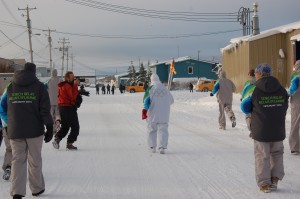
Photo: Steve Selden
On November 8, 2009 the Olympic games ceremonial torch appeared out of the snowy, frigid air on Kelsey Boulevard. One could feel the anticipation in the air as we all waited for the delayed torch to appear from the airport and into town. Once arrived, it was ushered around Churchill and down behind the town complex where the bearer boarded a tundra rover and gazed out over the Hudson bay. Snow and cold made that morning all the more memorable though the real memory will be the feeling that came with the torch to this tiny frontier town on the Hudson bay.
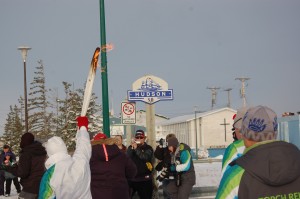
Photo: Steve Selden
Innocence and purity are words that come to mind when I think of that day as I fervently followed the torch from place to place snapping photo’s with freezing fingers. I had been to the Winter Olympics of 2002 in Salt Lake City, Utah and will never forget the feeling of world unity through competition. The indescribable feeling that we are one people can be felt at the Olympic games for that far too short period of two weeks. You become isolated in a bubble of hope and belief that there is possibly a solution to countries fighting over land and ideals that does not end in war. It’s euphoric and hopeful.
I felt that again..even more-so, in the town I had spent a good amount of my life in over the past ten years- most likely because Churchill to a large extent is innocent and removed from the worldly pain that takes place each day. It is surely removed geographically …if the predominant gales were from the South instead of North, the town itself would slide across the frozen tundra and disappear into the steely Hudson Bay. Not to say they don’t have their human turmoil like every place; but comparably Churchill is a safe haven for the most part. The torch, on that November day, became one with the town and the hope of peace and freedom in the world. It’s a feeling I cannot explain to you in adequate words ..though you would know it if you felt it. It’s the embodiment of the Olympic spirit and the hope it holds for mankind and future generations to settle disputes peacefully.
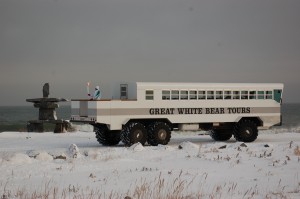
Photo: Steve Selden
by Steve Selden | Jan 21, 2011 | Tour News
Polar bears are out on the ice in the Hudson Bay hunting seals. At least in the Western Hudson Bay. The Eastern coast and extending out some distance has been lacking in ice as a result of weather patterns, currents and an unusually late freeze-up in the bay overall. As a result bear population on the Western half is more saturated.

Photo: Steve Selden
The weather is settling back into normal, frigid Winter conditions as mentioned in my last post. Despite some Churchillians claim that this winter has been “warm”..yes warm, the temperatures are currently in the -30C range almost daily. The outlook for the next week or so is for the mercury to drop close to -50C with winds of 60 kilometers …more like the mean for January in the North. With extended cold such as this, the Eastern Hudson Bay should play catch -up fairly quickly. Seal populations should remain steady as they will still have ample birthing platform available to the West. This condensed area could be opportunity for polar bears to have a solid Winter of energy storage. Should be interesting to observe their weights this Summer.

Photo: Steve Selden
With the good also comes..well…the not so good. Unless your an Inuit hunter holding a polar bear tag this Winter. Hunting around Baffin Island and the Davis Straits has commenced with quotas increased this year. Limits on takes have increased from 16 males and seven females to 32 males and nine females. The Inuit contend that unused tags from previous years are being totaled for this year’s limit rather than an increase in quota overall. I’ll dig up more information on this and keep you all informed in future posts. It will be interesting to see how ice conditions factor into this year’s hunt as well.
CBC News Story On Iqaluit Polar Pear Quota Increase
by Steve Selden | Jan 12, 2011 | Tour News
Winter has settled in to a more predictable pattern in Churchill these days with temperatures consistently in the -25C range. Snow has been falling for the last day or so though the outlook for the rest of the week is clear and cold. Ice coverage in the Hudson Bay is catching up quickly to the mean for this time of year and polar bears are surely happy with that fact. Occasional spectacular Aurora Borealis (Northern lights) displays have been making their appearance…as the “high” season for viewing this amazing phenomena, approaches. Soon brave travelers from across the world will be coming to Churchill in February to take it all in. I’ll keep you updated on the action in the sky as well as daytime activities on the snowy tundra.

Photo: Colby Brokvist
Continuing with our recap of this past polar bear season in photo’s, here are a few more images to remember it by. These were some beautiful shots captured by people close to the bears. They tell the story of some trends we saw throughout a weird, unique season.

Photo: Paul Brown
In a season when ice coverage in the bay was at least two weeks behind the norm in the month of November, numerous seal kills were documented with polar bears feeding on the carcasses. For some bears this pre-season sustenance can be the bridge to survival. Are the bears adjusting to shorter ice seasons with keener hunting techniques or are more seals being pushed on land due to the lack of early ice formation?

Photo: Paul Brown
Sparring was a featured occurrence for travelers virtually every day once the season was in full gear. Male bears were overall regarded in healthy shape and willing to exert their precious energy while waiting on the tardy ice to form. Even females were observed roughing it up as agitation in a crowded Churchill Wildlife Management Area escalated.
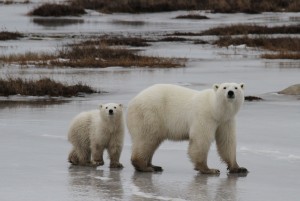
More sows with cub(s) were reported than in past years. Not sure if this signifies anything or not but it did make for a widely diverse behavioral stage on the tundra. There was also more aggressive action by male bears toward the mom’s with cubs….only natural.
by Steve Selden | Jan 4, 2011 | Tour News
The new year has started with much colder temperatures and light snow from time to time. Currently the temperature range has been in the -15C to -20C range with the wind chill approaching -30C. Sunrise is just past 9am and sunset just after 3:30pm in the afternoon…short days though more than farther Northern arctic communities.
With the new year upon us, I’d like to look back at some of the fantastic photo’s in two or three parts from polar bear season and recap some of the highlights as we sit back while the bears are out on the ice gaining sustenance. I will present the pics in order of what I thought were most incredible. Ok, here we go.

Photo: Curtis Bouvier

Photo: Curtis Bouvier

Photo: Curtis Bouvier
These three photo’s have to be shown together in sequence to get a complete grasp on the encounter’s intensity. These were taken by Curtis Bouvier who is the nephew of good friend and long -time rover driver and tundra lodge manager Ed Bouvier. Ed has left Churchill while his nephew drove a rover this past season. These are truly unique and rare photo’s as this scene has not been seen by anyone I have been in contact with who lives or works in Churchill.

Photo: Colby Brokvist
In a season when the snow and cold stayed away early on, bears were viewed in a different light…such as this magnificent aura framing the bear. Sometimes, the contrast of the darker tundra can allow for more crisp shots without the glare of total white.

Photo: Colby Brokvist
Another by Natural Habitat guide Colby Brokvist. This one illustrates just how soft those Northern rocks (not Eric) are…it’s a little known fact.

Photo: Paul Brown
Our final photo for this segment is one by Natural Habitat Guide Paul Brown. This huge male perched in Precambrian shield granitoid rocks, feels solid and heavy. The shapes of the rocks juxtaposed against the mammoth bear are reminiscent of the iconic Henry Moore bronze abstract sculptures.
by Steve Selden | Dec 28, 2010 | Tour News
All quiet on the Western front…of the Hudson Bay that is… in Churchill, Manitoba. And, fairly warm for December for sure. Temperatures in the mid-teens persisted throughout the week. As the polar bear season becomes a distant memory for all, the town itself has slowed to a crawl despite the heat wave of sorts. 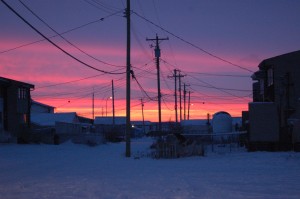
Most of the restaurants and a good many hotels have shut their doors for the Winter. Gypsy’s Bakery closed on November 30th and will re-open in early Spring. While the local mainstay has stayed open much later in recent years, sometimes through Christmas, the DaSilva family opted to close slightly earlier this time around…maybe to head back to visit family in Portugal for the holiday’s. Really, the only larger establishment in town still open is the Seaport hotel and restaurant on Kelsey Boulevard in the center of town. Mayor Mike Spence and his wife Lawreen have made a commitment to remain open for townspeople and Winter travelers all year long….the hot coffee flows all day.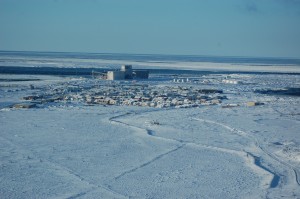
While the recent warmth has allowed local Churchillians to roam the land in the region without much discomfort, the polar bears are surely gone for now. The open water leads in the Hudson Bay are a product of the flowing river water emptying into the bay. However, the bay in general to the North, has supported enough ice to allow the bears to pursue their Winter diet of ringed seals. Open water on the Western half of the Churchill River has forced avid outdoors men and women to track further up-river to cross on snow machines. The increased current and tide flow nearer the port affect ice formation and thus passage across this time of year. Some locals maintain rustic cabins across river scattered on the tundra…used as get-away respites from the hustle and bustle of metropolitan Churchill proper. The old White Whale Lodge that used to be nestled in the sandy dune of the river bank almost directly across from the grain port, used to feel like a million miles away from civilization. Unfortunately flames reduced the structure to ashes some years ago.
While things are slow in Churchill over the next several weeks, I would like to give you all some characteristics of the “other” inhabitants of the region that don’t quite get the press that the majestic polar bears do. No..not the local people…although I will , from time to time, bring their stories to light as well. Their are a number of animal species that ride out the brutally cold Winter days either by choice or evolutionary ties. I’m sure describing some of their behavioral habits will open your eyes to their strength and perseverance.
Our first, the gray jay or whiskey jack,..from the family Corvidae, which includes ravens, jays,magpies and nutcrackers are widespread in the forested areas of Churchill. Anyone who has taken a dogsled excursion from one of the local operators has surely observed this bird flitting away and back around the base camp. Natural scavengers at heart, the name whiskey jack is derived from an Algonquin name -Wisakedjak- for a mischievous and disobedient mythical creature. One surely gets this feeling from the body language and vocalizations of this bird.

Gray jays mate for life and are territorial in feeding and nesting habits. Because they do not migrate or interbreed among their species, they are well adapted to specific local cold conditions as well as short growing seasons. They feed on a wide variation of insects, small animals such as frogs and moles as well as mushrooms, seeds and berries. Well adapted gray jays are able to reproduce at a relatively early point in the “season”. Between two and five eggs are laid as early as February when most if not all of their natural food source remains out of reach. What’s their secret?

Photo: Eric Rock
As a guide for over 15 years in the Churchill region, the word I spoke most often to travelers was “adaptability” or some form of it. Every living being, including humans, living in the North has to find ways to adapt to life there on a constant daily basis. The ones that cannot are forced to leave or die..the ones that can, find their spirit.
Gray jays spend most of the year preceding reproduction harvesting their food for Winter. They work countless beak-fulls of food into a sticky paste moistened by saliva. They cache these life giving treasures in a mentally mapped network of hidden places. Usually these spots are under flakes of spruce bark or amongst needles on evergreen branches safe from drifting snow or predators. These stored packets allow the jays a head start to life in the region before any of their migrant winged counterparts return from their warm Winter ranges much further South. Not everyone can afford a tropical home as you know. So instead of exhausting all that energy flying thousands of miles, gray jays opt for solace in the splendid boreal forests of the arctic landscape.
























